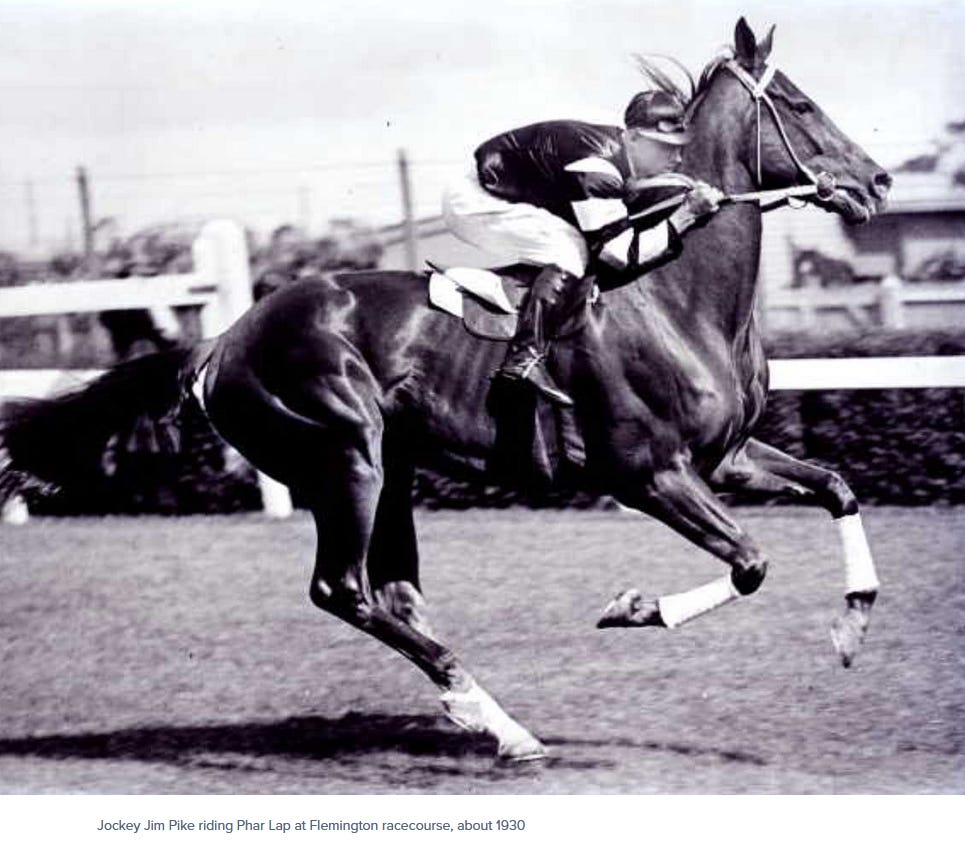Phar Lap's skeleton reveals a deeper story
Phar Lap, a chestnut thoroughbred gelding was born in Timaru, New Zealand on the 4th of October 1926 and died on the 5th of April, 1932 in California, USA due to catastrophic internal bleeding caused by what was believed to be poisoning.
All Aussies and New Zealanders know something about his story.
His valiant career lead him to being inducted into both the New Zealand and Australian Hall of Fame. He is ranked as #22 of the 100 Top U.S Racehorses of the 20th Century.
Phar Lap had a distinguished career, winning 37 of his 51 starts. His wins included:
AJC Derby (1929)
Victoria Derby (1929)
W. S. Cox Plate (1930, 1931)
Melbourne Cup (1930)
C.B. Fisher Plate (1930)
St George Stakes (1931)
Memsie Stakes (1931)
Agua Caliente Handicap (1932) and many others
This is a vintage film of Australia's greatest racehorse, and one of the best in the world, the magnificent Phar Lap. You can see the documentary footage of his last race in Australia here:
In his short time on the earth ( 1926-1932) Phar Lap ( nicknamed, 'Bobby', and the 'Red Terror') won two Cox Plates, a Melbourne Cup (bigger than the Kentucky Derby), and 19 other weight for age races.
He was shipped by boat to Agua Caliente Racetrack in Mexico to compete in the Agua Caliente Handicap, which offered the largest purse ever raced for in North America.
Phar Lap won in track record time carrying 129 pounds, despite the arduous Boat trip of months at sea. He was then taken up to a private ranch in Menlo, California where preparations where made to race him against the best in the United States.
It was here that a hero of a Nation died.
Phar Lap, hemorrhaged to death. Aussies always suspected the Americans poisoned him, and in 2008, thanks to modern science, it was confirmed that Australia's hero died from a massive dose of arsenic.
Phar Lap stands proud in the Melbourne museum in Australia. His body was stuffed after his death, and it is there that many pay a pilgrimage to the 'horse that stopped a nation.' During the long dark days of the Great Depression he was Australia's sunshine.
Phar Laps heart is also on display at the Melbourne Museum. Phar Lap was a freak. His heart weighs 6.2 kgs (13.6 pounds) Compared with a normal horses heart at 3.2 kg (7 pounds.) Phar Lap will NEVER be forgotten.
You can read more about his display at the Melbourne Museum here.His life was so short, we always wonder what he could have achieved if he had gone on racing. It is so amazing that a Horse who has been dead almost 80 years, can still bring many Aussies to tears.
I encourage all to watch the movie Phar Lap: Heart of a Nation was released, telling his story. It is a truly beautiful movie, but have the tissues ready!!
You can find the movie here
His skeletal remains are on display at the Te Papa Museum in Wellington, New Zealand. I was lucky enough to view it, on my recent visit last month.
This is the story of his skeleton in New Zealand.
So what stories do his bones have to tell?
Here are just some of them.
Thank you to Zoe Braddock for providing the photos on this Facebook post where you can see each one. Read the captions on each photo to learn what this mighty horse dealt with in his body here.
If you feel so inclined, you can also sign this petition: https://chng.it/cnjVY2JKcH
Did you know?
How many bones does a horse have?
A horse typically has 205 bones, but the exact number can vary by breed. For example, some breeds of horses, like Arabs, may have fewer bones in their spine.
Here are some of the bones in a horse's skeleton:
Vertebral column
The backbone, which is made up of 54 vertebrae. The first two vertebrae, the atlas and axis, allow the horse to move its head in all directions.
Rib cage
Made up of 36 ribs, but some breeds may have 37 or 38. The sternum is located in the center of the rib cage.
Limbs
The forelimbs have 20 bones, and the hindlimbs have 19 bones. The horse's "knee" (carpus) is made up of 10 bones, which is similar to the human wrist.
Skull
Consists of 34 bones.
Femur
The longest bone in the horse's body, which connects the pelvis to the tibia.
The horse's skeleton protects vital organs, supports soft parts of the body, and provides a framework. The alignment of the bones determines the horse's movement, efficiency, and conformation.








My heart breaks for this horse. Too much time has passed or you could give me a name and an address and I’ll be more than happy to take care of it. One thing I cannot tolerate any form of abuse, especially on an animal. I’ve rescued Missouri Foxtrotter’s and donkey in the large animal arena.
Unfortunately, in these type of sports, and it’s also with greyhound racing, my parents used to do that and they trained, bred and owned their own kennels around the country, and we had the second dog in the world. Black Regatta.
Thank you for writing the article because the horse may be remembered by how he died and that’s tragic.
No doubt he’s a worldwide sporting icon.
I was unable to read the skeletal info to see what injuries he undoubtedly ran with.
Is it just me that struggles with drop boxes and other bibs and bobs on this platform ?